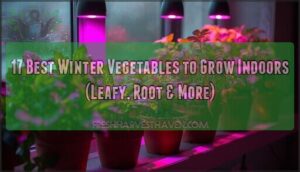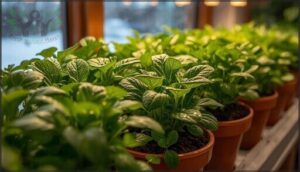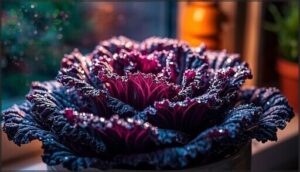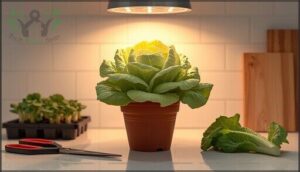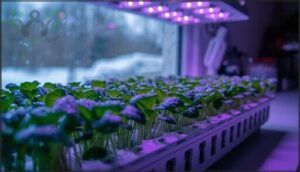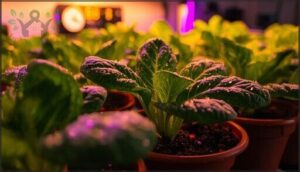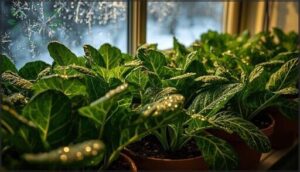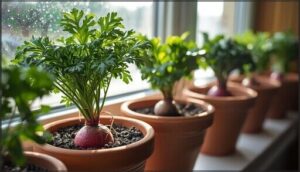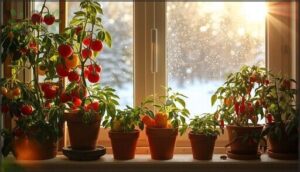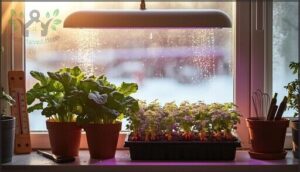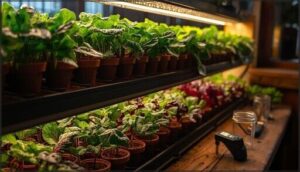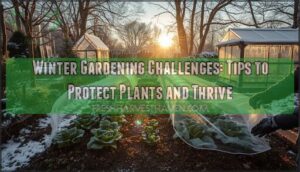This site is supported by our readers. We may earn a commission, at no cost to you, if you purchase through links.
Your windowsill just became the most productive spot in your home. While outdoor gardens go dormant and grocery store prices climb, you can grow fresh vegetables right in your living room. Indoor winter gardening isn’t just possible—it’s easier than you might think.
Leafy greens thrive under simple LED setups, root vegetables adapt surprisingly well to containers, and even fruiting crops like tomatoes and peppers keep producing when you dial in the basics. The secret isn’t fancy equipment or a green thumb. It’s choosing vegetables that actually want to grow indoors and giving them the light, temperature, and care they crave.
These 17 varieties will turn your indoor space into a winter harvest station.
Table Of Contents
- Key Takeaways
- Top Leafy Greens for Indoor Winter Growing
- Best Root Vegetables to Grow Indoors
- Fruiting and Unique Indoor Winter Vegetables
- Key Indoor Growing Conditions for Winter Success
- Tips to Maximize Indoor Vegetable Yields
- Frequently Asked Questions (FAQs)
- Can you grow veggies indoors in winter?
- What is the best plant to grow indoors in winter?
- What is the easiest vegetable to grow in winter?
- What is the easiest vegetable to grow indoors?
- What vegetables can you grow inside in the winter?
- Can I grow vegetables indoors all year?
- What vegetables can you grow indoors in the winter?
- What vegetable plants can you overwinter indoors?
- Can I grow vegetables in my house during the winter?
- What is the easiest winter veg to grow?
- Conclusion
Key Takeaways
- Leafy greens like arugula, kale, and lettuce are the fastest and most forgiving crops for indoor winter growing, delivering harvests in as little as 20-30 days with basic LED lights and minimal space.
- Root vegetables including radishes, beets, and carrots adapt surprisingly well to container growing indoors if you use pots at least 10-12 inches deep and maintain consistent moisture with 12-16 hours of daily light.
- Success hinges on four non-negotiables: full-spectrum LED grow lights positioned 12-24 inches from plants, temperatures between 60-75°F, well-draining soilless potting mix with proper pH, and strategic watering every 7-10 days based on soil moisture checks.
- Maximizing yields comes down to smart space management through vertical stacking, cut-and-come-again harvesting of outer leaves every 1-2 weeks, and succession planting new containers every three weeks to ensure continuous fresh harvests all winter.
Top Leafy Greens for Indoor Winter Growing
Leafy greens are the superstars of indoor winter gardening because they don’t need much space and they grow fast. Most are ready to harvest in just a few weeks, making them perfect if you’re new to this whole indoor growing thing.
Here are six reliable varieties that’ll give you fresh salads all winter long.
Arugula ‘Astro’
Arugula ‘Astro’ is a powerhouse for indoor gardening beginners. This leafy green thrives under grow lights and delivers baby-leaf harvest in just three to four weeks. Here’s what makes it perfect for winter vegetables indoors:
- Seed germination happens in 3–7 days at room temperature
- Indoor sowing works in any 6-inch pot
- Leaf harvest can repeat two to three times per planting
- Arugula nutrition packs vitamin K, calcium, and folate
- Astro growth tolerates cooler indoor spaces beautifully
For ideal growth, Astro arugula prefers well drained soil conditions to prevent waterlogged roots.
Kale ‘Dazzling Blue’
If you want a leafy green that’s as tough as it’s beautiful, Dazzling Blue kale is your answer. This variety flaunts striking purple-tinged leaves and delivers baby-leaf harvests in just 30 days under grow lights.
Kale nutrition is off the charts—one cup provides 684% of your daily vitamin K. Indoor kale growth thrives in 3–5 gallon containers with 12–16 hours of light daily.
Dazzling Blue kale is particularly suitable for cold weather crops due to its cold hardiness.
Lettuce ‘Buttercrunch Butterhead’
For tender, buttery leaves all winter long, Buttercrunch butterhead lettuce delivers superb flavor in just 50–60 days. This indoor gardening champion produces compact 4.5-inch heads under grow lights, making it perfect for shelf or countertop setups.
Your winter crop management becomes seamless with these buttercrunch varieties benefits:
- Leaf harvesting starts early—snip outer leaves for continuous salads
- Indoor sowing every two weeks ensures non-stop leafy greens
- Lettuce care requires only 12–16 hours of LED light and consistent moisture
Place containers 6–12 inches below fixtures for best results.
Mizuna ‘Mizuna’
If you’re looking for a lightning-fast leafy green, mizuna delivers tender microgreens in just 20–25 days under grow lights. This cold-hardy Japanese mustard thrives in cool indoor spaces (50–68°F), making winter gardening straightforward.
Seed germination starts at a chilly 40°F, while indoor lighting at 125+ µmol ensures lush growth.
Mizuna nutrition shines with low calories and high calcium—perfect for continuous harvest timing every few weeks.
Spinach ‘Bloomsdale’
Bloomsdale spinach delivers thick, crinkled leaves packed with vitamin K and iron—about 310% and 24% of your daily value per serving—making it a nutritional powerhouse for winter gardening.
Seed germination kicks off in 7–14 days when you maintain cool indoor climate conditions between 60–75°F. This slow-bolting variety lets you practice leaf harvesting for weeks, thriving in quality soil with consistent moisture and 14–16 hours of grow light daily.
Collards ‘Georgia Southern’
Georgia Southern collards offer a cold-hardy winter crop with impressive nutrition—339% daily vitamin K and 14% calcium per serving.
Start seeds ¼-inch deep in 12–16 inch pots filled with compost-enriched soil, spacing 6 inches apart.
These leafy greens mature in 70–75 days under bright LED lights, tolerating cool indoor temps around 60–70°F while delivering multiple harvests throughout winter.
Best Root Vegetables to Grow Indoors
Root vegetables might seem tricky to grow indoors, but they’re actually more forgiving than you’d think. You just need deeper containers and a little patience while they develop underground.
Here are five excellent root vegetables that adapt surprisingly well to indoor growing conditions.
Beets ‘Gourmet Beet Blend’
You’ll love ‘Gourmet Beet Blend’ for its dual harvest—earthy roots and nutritious greens packed with beet nutrition. This seed selection mixes classic and golden beet varieties for colorful indoor sowing.
Plant them in containers at least 10–12 inches deep to support strong root development. With 12–14 hours of light daily and proper indoor gardening techniques, these root vegetables mature in about 55 days, making winter gardening tips come alive.
Carrots ‘Carnival Blend’
‘Carnival Blend’ brings a rainbow of purple, red, white, yellow, and orange carrots to your indoor gardening setup. These root vegetables need deep containers—at least 12 inches for proper root development—and patience, as indoor soil conditions mean carrot germination takes 10–15 days and harvest stretches to 120 days.
- Plant seeds in loose, well-draining indoor soil to prevent forked roots
- Thin seedlings to 2 inches apart for ideal carrot varieties growth
- Provide 12 hours of LED light daily for strong root development
- Keep temperatures cool and moisture consistent throughout container gardening
- Expect baby-carrot-sized harvests when growing winter vegetables indoors, plus reliable seed storage for three years
Radish ‘French Breakfast’
Need fast results from your indoor gardening project? French Breakfast radish delivers crisp, mildly peppery roots in just 24–30 days—ideal for winter gardening when you want quick wins. These oblong root vegetables stay tender at 3 inches long and thrive in cool indoor sowing conditions between 35–65°F.
Keep soil consistently moist for growing winter vegetables indoors—dry spells slow growth, while overwatering splits roots. Each 85-gram serving provides radish nutrition perks: just 15 calories, 1 gram of fiber, and 20 milligrams of calcium. Sow seeds every two weeks for continuous harvests throughout your indoor gardening season.
| Radish Care Essentials | Your Action |
|---|---|
| Seed starting depth | Sow 0.5 inches deep |
| Spacing after thinning | 2 inches between plants |
| Light requirement | Full LED grow light daily |
| Harvest timing | When roots reach 3 inches |
Turnip ‘Market Express’
‘Market Express’ turnip rewards impatient indoor vegetable gardening fans with sweet white roots ready in just 30–40 days from seed selection. This cool-season champ thrives at room temperature, making winter indoor sowing a breeze. Here’s your turnip care roadmap:
- Sow seeds 6mm deep directly in containers—transplanting stunts root development
- Thin seedlings to 4–6 inches apart for uniform sizing
- Harvest baby roots at 2 inches (30 days) or full-size at 4–5 inches (40–50 days)
- Use containers at least 15–20cm deep to avoid deformed roots
- Snip nutrient-packed leafy greens anytime for salads—they’re loaded with vitamin K and calcium
Direct seed into well-draining pots, keep soil moist, and enjoy continuous harvest timing by sowing fresh batches every two weeks throughout your indoor gardening season.
Rutabaga ‘American Purple Top’
‘American Purple Top’ rutabaga demands patience—three to four months from indoor sowing to harvest timing—but delivers sweet, globe-shaped roots packed with vitamin C and fiber. Seed germination takes up to two weeks, so start early in your winter indoor vegetable gardening calendar.
These cool-season root vegetables need 12-inch-deep containers and 12–16 hours of daily light for proper root development. The leafy vegetables double as nutritious greens while you wait.
Fruiting and Unique Indoor Winter Vegetables
If you’re ready to go beyond leafy greens and root crops, fruiting vegetables offer a rewarding challenge for your indoor winter garden. These plants need a bit more attention—think stronger light, deeper pots, and sometimes a trellis—but they’ll give you homegrown tomatoes, peppers, and more when the ground outside is frozen solid.
Let’s look at six options that can actually produce fruit indoors during the coldest months.
Broccoli ‘Burgundy’
This sprouting broccoli reaches 24-36 inches tall and thrives with indoor gardening techniques perfected for winter harvest. After you cut the central head, it rewards you with tender side shoots packed with broccoli nutrition—91% of your daily vitamin C and more calcium absorption than milk.
Crop rotation principles apply indoors too: maintain soil quality with proper pH levels between 6.0-7.0, and keep temperatures at 60-70°F for leafy greens and growing vegetables indoors successfully.
Broccoli Raab ‘Rapini’
If you want something even faster than sprouting broccoli, rapini delivers harvest-ready shoots in just 25 days after transplanting. Keep your indoor climate between 60-65°F during growth stages, and watch seed germination happen within a week.
This Mediterranean green gives you multiple harvests—just snip those leafy shoots before flowers open, and new ones keep coming for weeks of nutrient-packed winter greens.
Cauliflower ‘Romanesco’
Growing Romanesco requires patience—75 to 100 days from transplant. Proper indoor spacing, with one plant per 5-gallon pot, and balanced soil nutrition are essential to prevent cauliflower diseases and encourage the development of its stunning fractal heads.
Maintain steady temperatures between 65-75°F and ensure each plant has about 24 inches of breathing room.
Your Romanesco harvest rewards careful planning with show-stopping winter vegetables, proving that indoor vegetable gardening can yield something truly remarkable.
Indoor Tomatoes
Tomatoes thrive indoors with 16-18 hours of daily LED lighting and temperatures around 70-82°F. Compact varieties like ‘Micro Tom’ fit perfectly in small pots, needing just 6 inches of depth with well-draining tomato soil mix.
You’ll harvest 40-80 pounds annually from a modest setup. Watch for whiteflies and hornworms—pest management keeps your fruit production strong through winter’s darkest months.
Indoor Cucumbers
Cucumbers demand more attention than leafy greens, but they’ll reward you with crisp harvests all winter long. English varieties work beautifully in container gardening setups with hydroponics or quality soil.
- Use 7-10 gallon pots with trellises for vining cucumber varieties
- Provide 14-16 hours of LED lighting daily for vigorous growth
- Maintain 26-28°F daytime temperatures and keep soil consistently moist
- Hand-pollinate flowers indoors since bees won’t visit your growing vegetables indoors setup
Bell Peppers in Pots
Bell peppers thrive in container gardening when you give them room to spread their roots. Use 5-gallon pots with well-draining soil quality and expect 15-20 peppers per plant.
Water management matters—let the top half-inch dry between waterings. Apply fertilizer monthly, watch for aphids during pest control checks, and provide strong lighting.
Growing vegetables indoors means controlling every detail for success.
Key Indoor Growing Conditions for Winter Success
Growing vegetables indoors during winter isn’t complicated, but you do need to get a few basics right. Your plants won’t thrive without proper light, the right temperature range, quality soil, and a consistent care routine.
Let’s break down the four essential conditions that’ll set you up for success.
Using LED Grow Lights
Your indoor garden won’t thrive without the right light, and LED grow lights are the breakthrough for growing vegetables indoors year-round. They’re energy-efficient workhorses that mimic natural sunlight perfectly for leafy greens and microgreens.
Here’s what makes LEDs ideal for indoor gardening:
- LED spectrum: Blue light (400–500 nm) strengthens seedlings, while red light (600–700 nm) aids fruiting crops
- PPFD targets: Leafy greens need 200–400 μmol/m²/s; fruiting vegetables require 600+ μmol/m²/s
- Lighting schedules: Run lights 10–12 hours daily for consistent winter growth
- Energy efficiency: LEDs last 10× longer than fluorescents and produce less heat, letting you position them closer to plants
Temperature and Humidity Control
You’ve mastered grow lights—now let’s tackle thermal regulation and humidity management. Keep your indoor gardening space between 60-75°F for leafy greens like lettuce and spinach, which thrive in cooler conditions. Aim for 50-70% humidity to prevent fungal issues.
Use a simple hygrometer for temperature monitoring, and add a small fan for air circulation. These climate control basics transform winter gardening from tricky to triumphant.
Choosing The Best Potting Soil
Think of potting soil as your plants’ foundation—get this wrong, and everything else falls apart. For container gardening success, choose soilless mixes with at least 85% total porosity.
The ideal pH balance sits between 5.4 and 6.2, keeping nutrients available to leafy greens and root crops. Look for blends combining peat or coir with perlite for drainage—this soil composition balances moisture levels while preventing soggy roots.
Proper Watering and Fertilization
Once you’ve nailed your soil quality, water balance and fertilization become your daily rhythm. Indoor gardening success hinges on checking soil moisture before watering—stick your finger in about an inch deep. Most winter vegetables need watering every 7-10 days indoors, far less than summer outdoor schedules.
- Water leafy greens like kale and lettuce with about 0.6-0.9 gallons per square foot weekly
- Use a balanced 10-10-10 fertilizer ratio for general vegetable needs
- Switch to higher-nitrogen formulas (12-6-6) for spinach and other nutrient-hungry greens
- Keep pH management between 5.5-6.0 for ideal nutrient cycling
- Bottom-water occasionally to distribute moisture evenly through root zones
Tips to Maximize Indoor Vegetable Yields
Growing vegetables indoors is one thing—getting them to produce bountifully is another. A few smart adjustments to your setup can mean the difference between a few scraggly leaves and a thriving harvest all winter long.
Growing vegetables indoors is one thing—getting them to produce bountifully requires smart adjustments that transform scraggly leaves into thriving winter harvests
Here’s how to get the most from every pot and every square inch of space you’ve got.
Arranging Plants for Optimal Light
When you set up your grow room, smart plant placement makes every watt count. Position your tallest crops—like tomatoes or peppers—at the edges of your LED fixtures, where light naturally drops off. Place your leafy greens front and center, directly under the strongest beam. Group crops with similar light needs together, and consider vertical gardening to layer plants at different heights.
Adding reflective surfaces—white paint or Mylar lining—bounces artificial light back toward your indoor garden, cutting waste and evening out light distribution across every plant.
| Crop Type | Ideal PPFD Range | Distance from LED Fixtures |
|---|---|---|
| Seedlings & transplants | 200–400 µmol/m²/s | 24–36 inches |
| Leafy greens (lettuce, spinach) | 250–450 µmol/m²/s | 18–24 inches |
| Fruiting crops (tomatoes, peppers) | 400–1,200 µmol/m²/s | 12–18 inches |
| Herbs & microgreens | 200–350 µmol/m²/s | 18–30 inches |
| Root vegetables (carrots, beets) | 300–500 µmol/m²/s | 18–24 inches |
Managing Space in Small Indoor Gardens
Vertical gardening transforms tight quarters into high-yield zones. Stack shelves to triple your floor space—a two-by-two-foot footprint can hold eight or more containers when you go up instead of out.
Arrange lettuce and spinach on upper tiers where headroom stays low, and reserve lower levels for taller crops like kale.
Compact growing means every inch works harder, turning urban gardening challenges into smart space optimization wins.
Harvesting and Replanting Strategies
Cut-and-come-again harvesting keeps leafy greens productive for weeks. Snip lettuce and arugula about an inch above the soil, and they’ll bounce back in seven to ten days. Here’s how yield optimization works in your winter gardening setup:
- Harvest scheduling: Pick outer leaves every one to two weeks while leaving at least half the foliage for regrowth management.
- Succession sowing: Start new containers every three weeks to avoid gaps.
- Soil renewal: Replace exhausted plants after three to five cuts when regrowth slows.
This crop rotation approach stretches your indoor gardening harvests across the entire season.
Sustainable Indoor Gardening Practices
Often, switching to LED grow lights cuts your electricity use by a third while boosting energy efficiency across the season. Water conservation thrives in recirculating setups—they slash usage by 70–90% compared to outdoor beds.
Choose peat-free potting mixes for better soil health and eco-friendly growing. Organic gardening methods with compost-based fertilizers support waste reduction and keep your sustainable indoor gardening system humming all winter long.
Frequently Asked Questions (FAQs)
Can you grow veggies indoors in winter?
Yes, you can grow vegetables indoors during winter. With LED grow lights providing 12-16 hours of daily light and warm indoor temperatures, leafy greens, herbs, and even root vegetables thrive year-round in containers.
What is the best plant to grow indoors in winter?
Loose-leaf lettuce stands as your champion for indoor gardening in winter—think of it as the starter plant that launches a thousand salads.
It tolerates shade, grows quickly, and thrives in cool indoor conditions year-round.
What is the easiest vegetable to grow in winter?
Lettuce stands out as the easiest winter crop for indoor gardening.
It thrives with moderate indoor lighting, tolerates cool temperatures naturally present in winter homes, and delivers fresh harvests in just 30–40 days.
What is the easiest vegetable to grow indoors?
Leafy greens like lettuce and spinach are perfect for indoor gardening for beginners—they mature in just four to six weeks with basic grow lights and consistent moisture, making them effortlessly rewarding.
What vegetables can you grow inside in the winter?
You can grow a surprising variety of vegetables indoors during winter. Cool-season leafy greens like spinach and kale thrive alongside compact root vegetables, herbs, and even fruiting crops with proper indoor gardening tips and vegetable lighting.
Can I grow vegetables indoors all year?
You can absolutely hit the ground running with year-round gardening indoors. Control your indoor climate, pick fast-maturing vegetables, and use growing techniques like LED lights to harvest fresh greens every season.
What vegetables can you grow indoors in the winter?
You can grow plenty of vegetables indoors during winter. Leafy vegetables like spinach and kale thrive alongside root crops such as radishes.
Growing vegetables indoors works well with microgreens, peppers, and tomatoes when you provide proper vegetable lighting needs.
What vegetable plants can you overwinter indoors?
You can overwinter peppers, kale, and chard indoors by bringing container plants inside before frost hits.
These hardy survivors need frost protection, steady indoor climate control, and decent soil quality to keep producing through winter.
Can I grow vegetables in my house during the winter?
You can successfully grow fresh vegetables in your house during winter by maintaining proper indoor climate, using grow lights, ensuring good soil quality, and optimizing space—making winter vegetable gardening productive year-round.
What is the easiest winter veg to grow?
Leafy greens are your gateway crop—lettuce, spinach, and arugula succeed on the first try for 81% of beginners.
These cold-hardy champions reach harvest in just 30 days under basic LED lights, making winter gardening practically foolproof.
Conclusion
Picture yourself in February, trimming fresh lettuce for dinner while snow piles up outside. That’s the freedom indoor winter gardening gives you.
You’ve got the plant list, the lighting basics, and the container know-how to pull it off. Now it’s about choosing your first three best winter vegetables to grow indoors and getting them started.
Your windowsill won’t know what hit it—and neither will your grocery bill.
- https://www.anthropocenemagazine.org/2023/09/indoor-lettuce-produces-double-the-yields-doubly-fast/
- https://extension.illinois.edu/news-releases/indoor-gardening-can-brighten-winter-doldrums
- https://blogs.ifas.ufl.edu/orangeco/2020/04/09/artificial-lighting-for-growing-vegetables-at-home/
- https://integratedlightingcampaign.energy.gov/unlocking-plant-growth-potential-leds-indoor-horticulture
- https://laidbackgardener.blog/2020/10/12/growing-vegetables-indoors-over-the-winter-not-so-simple/

